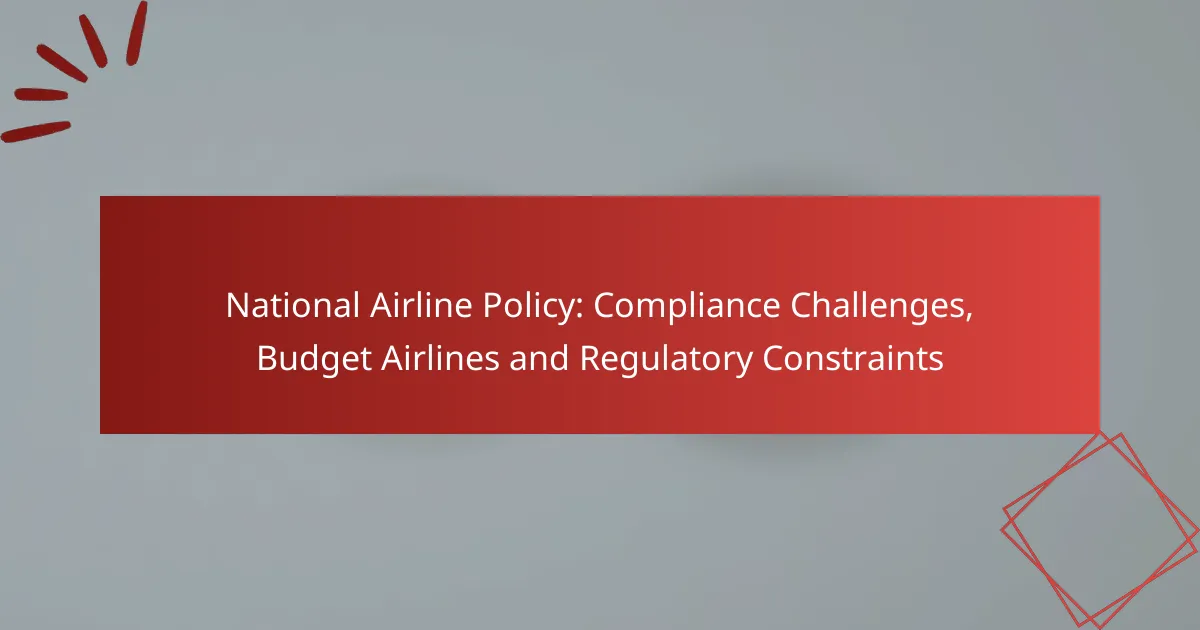The National Airline Policy is a complex landscape where compliance challenges, budget airlines, and regulatory constraints intersect. National airlines grapple with stringent regulatory requirements and financial pressures that can hinder their operational efficiency. In contrast, budget airlines employ innovative strategies to navigate these regulations while maintaining competitive pricing and service quality. Understanding the key regulatory frameworks, such as those from the FAA and DOT, is essential for airlines to thrive in this dynamic environment.
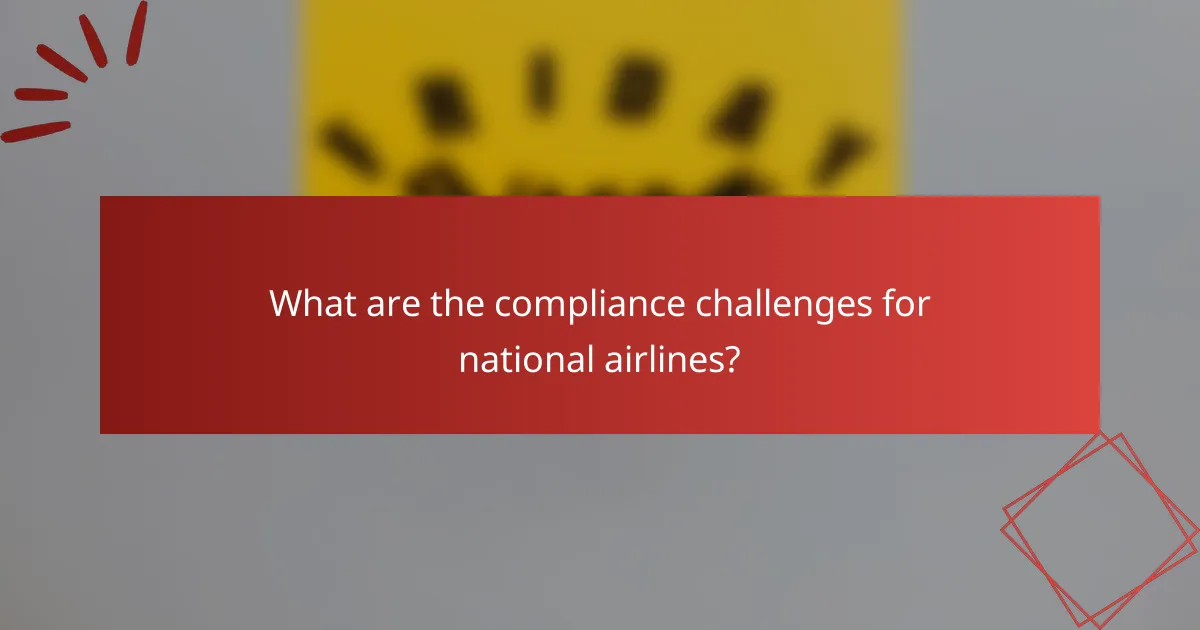
What are the compliance challenges for national airlines?
National airlines face numerous compliance challenges that stem from regulatory requirements, operational limitations, and financial pressures. These challenges can significantly impact their ability to operate efficiently and competitively in the aviation market.
Regulatory complexities
National airlines must navigate a complex landscape of regulations that vary by country and region. Compliance with international standards set by organizations such as the International Civil Aviation Organization (ICAO) is essential, but local laws can introduce additional layers of complexity.
For instance, airlines operating in the European Union must adhere to stringent EU regulations regarding safety, environmental impact, and passenger rights. This often requires substantial investments in compliance systems and training for staff.
Operational constraints
Operational constraints arise from the need to align airline practices with regulatory requirements. This includes maintaining aircraft to specific safety standards and ensuring that crew members are adequately trained and certified.
Additionally, airlines may face restrictions on flight routes and schedules imposed by national governments. These limitations can hinder flexibility and responsiveness to market demands, affecting overall operational efficiency.
Financial implications
Compliance challenges can lead to significant financial implications for national airlines. The costs associated with meeting regulatory requirements, such as safety inspections and environmental compliance, can be substantial.
Moreover, non-compliance can result in hefty fines and operational disruptions, further straining financial resources. Airlines must carefully balance compliance costs with the need to remain competitive, often leading to tough budgetary decisions.
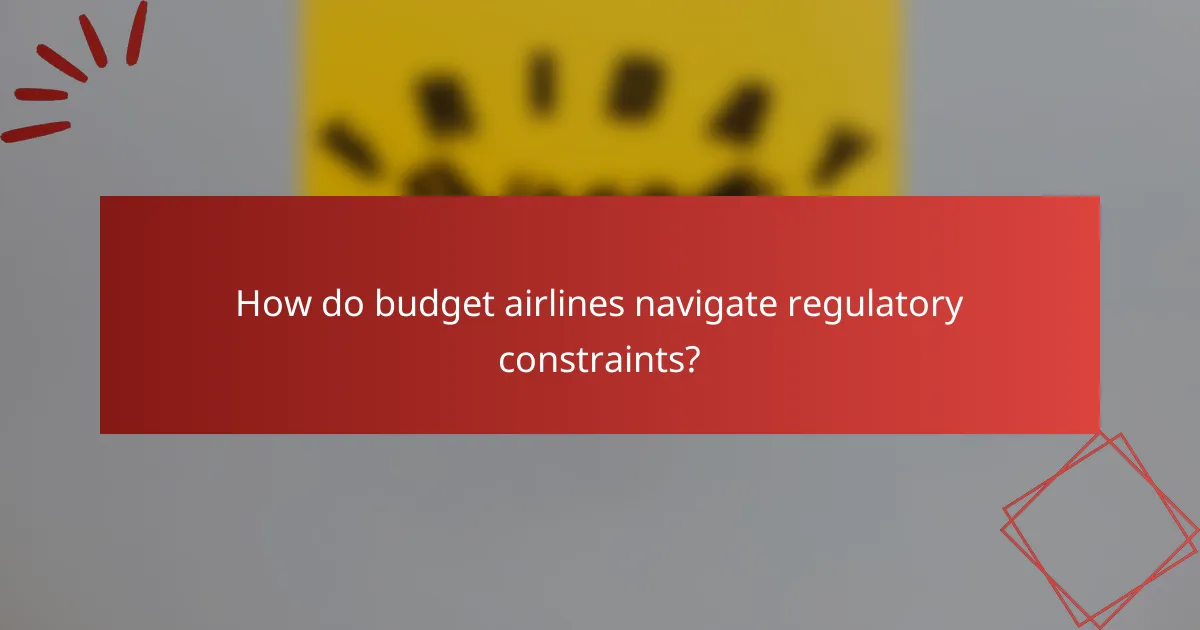
How do budget airlines navigate regulatory constraints?
Budget airlines navigate regulatory constraints by implementing innovative strategies that focus on cost efficiency and operational flexibility. They often adapt to regulations while maintaining competitive pricing, ensuring compliance without sacrificing service quality.
Cost-cutting measures
Budget airlines employ various cost-cutting measures to stay competitive while adhering to regulations. These include minimizing overhead by using a single aircraft model, which simplifies maintenance and training. Additionally, they often operate from secondary airports, which typically have lower landing fees compared to major hubs.
Another common strategy is to reduce in-flight services, offering a no-frills experience that allows them to charge for extras like baggage and meals. This approach not only lowers operational costs but also aligns with the expectations of their price-sensitive customers.
Operational flexibility
Operational flexibility is crucial for budget airlines as it allows them to quickly adapt to changing regulations and market conditions. They often utilize dynamic scheduling and route optimization to maximize aircraft utilization and minimize downtime. This agility helps them respond to demand fluctuations without incurring significant costs.
Moreover, budget airlines frequently adjust their operational practices to comply with new regulations, such as implementing safety measures or environmental standards. This adaptability ensures they remain compliant while still offering competitive fares.
Partnerships with regulators
Building partnerships with regulators is a key strategy for budget airlines to navigate compliance challenges. By engaging in dialogue with regulatory bodies, they can better understand upcoming regulations and influence policy discussions that affect their operations.
These partnerships may also lead to collaborative initiatives, such as safety programs or environmental sustainability efforts, which can enhance their reputation and operational efficiency. Establishing a good rapport with regulators can help budget airlines anticipate changes and prepare accordingly, reducing the risk of non-compliance.
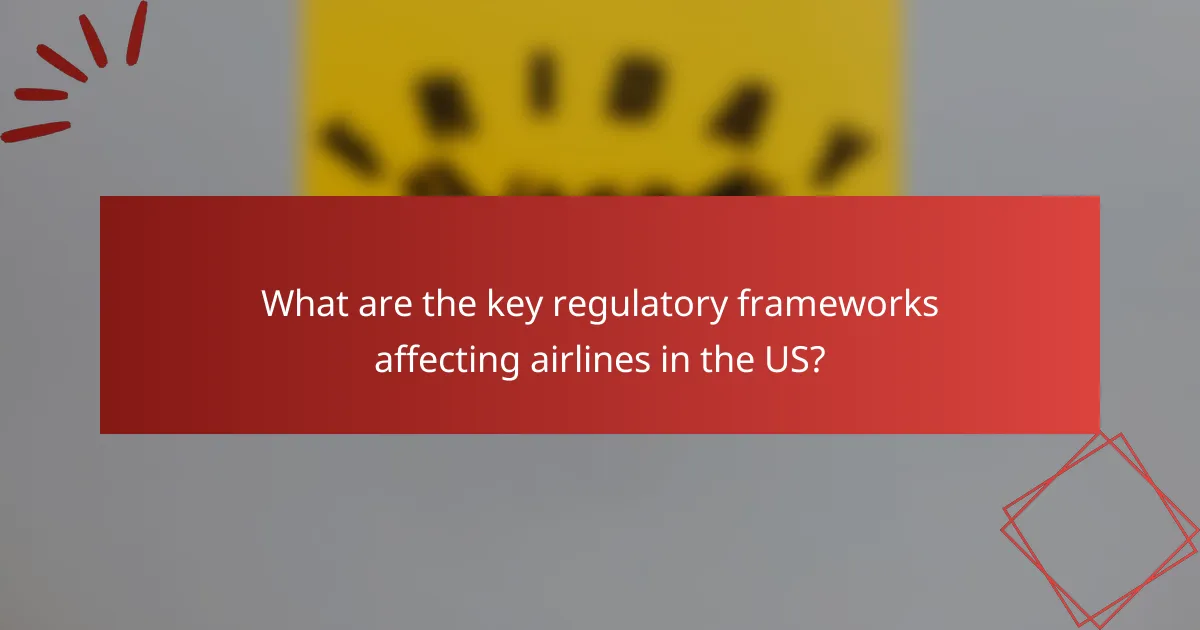
What are the key regulatory frameworks affecting airlines in the US?
The key regulatory frameworks affecting airlines in the US include guidelines from the Federal Aviation Administration (FAA), the Department of Transportation (DOT), and the International Air Transport Association (IATA). These frameworks govern safety, operational standards, and consumer protection, shaping how airlines operate within the country.
Federal Aviation Administration (FAA) regulations
The FAA is the primary authority overseeing civil aviation in the US, ensuring safety and efficiency in air travel. Its regulations cover a wide range of areas, including aircraft certification, pilot licensing, and air traffic control procedures.
Airlines must comply with stringent maintenance and operational standards set by the FAA. For example, regular inspections and adherence to safety protocols are mandatory to maintain operational licenses. Non-compliance can lead to significant penalties or grounding of aircraft.
Department of Transportation (DOT) guidelines
The DOT focuses on consumer protection and economic regulations within the airline industry. It enforces rules regarding ticket pricing, advertising, and passenger rights, ensuring transparency and fairness in airline operations.
Airlines are required to disclose all fees and provide compensation for flight delays or cancellations under DOT guidelines. For instance, if a flight is delayed for more than a few hours, passengers may be entitled to meals or accommodations, depending on the circumstances.
International Air Transport Association (IATA) standards
IATA is a global trade association that represents airlines and establishes industry standards. While not a regulatory body, its guidelines influence operational practices and safety protocols adopted by airlines worldwide, including those in the US.
Airlines often align with IATA standards to enhance operational efficiency and customer service. For example, IATA’s recommendations on baggage handling and ticketing processes help streamline operations and improve passenger experiences.

How do airlines ensure compliance with safety regulations?
Airlines ensure compliance with safety regulations through a combination of regular audits, staff training, and the implementation of safety management systems. These measures help maintain high safety standards and mitigate risks associated with air travel.
Regular audits and inspections
Regular audits and inspections are crucial for airlines to verify adherence to safety regulations. These assessments typically occur at scheduled intervals and may involve internal teams or external regulatory bodies. Airlines often conduct both announced and unannounced inspections to ensure ongoing compliance.
During these audits, airlines review operational procedures, maintenance records, and safety protocols. This helps identify any discrepancies or areas needing improvement, allowing for timely corrective actions.
Training programs for staff
Training programs for staff are essential in ensuring that all personnel are aware of and understand safety regulations. Airlines invest in comprehensive training that covers emergency procedures, equipment handling, and regulatory updates. Regular refresher courses help keep staff informed about the latest safety practices.
Effective training programs often include simulations and hands-on exercises, enabling staff to practice their responses to various scenarios. This practical approach enhances readiness and reinforces a culture of safety within the organization.
Implementation of safety management systems
Implementing safety management systems (SMS) is a proactive approach that airlines use to manage safety risks. An SMS provides a structured framework for identifying hazards, assessing risks, and implementing controls. This systematic method helps airlines prioritize safety initiatives based on data and analysis.
Key components of an SMS include safety policy, risk management, safety assurance, and safety promotion. By fostering a safety-oriented culture and encouraging reporting of safety concerns, airlines can continuously improve their compliance with safety regulations.
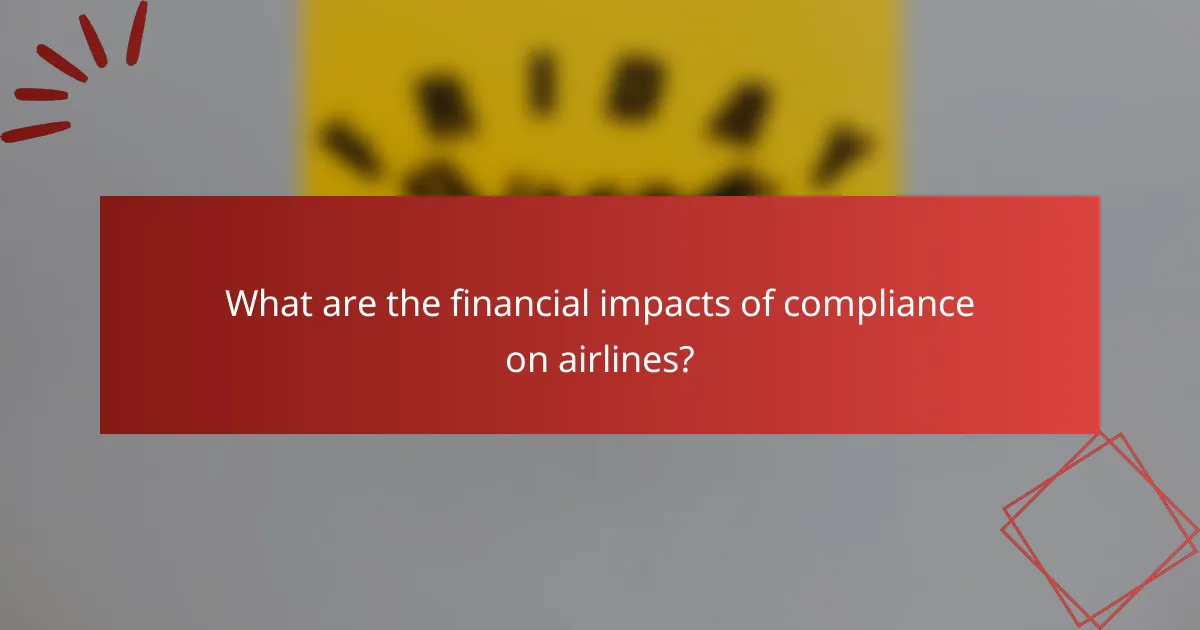
What are the financial impacts of compliance on airlines?
The financial impacts of compliance on airlines can be significant, affecting their overall profitability and operational efficiency. Compliance with regulations often leads to increased costs, potential fines, and adjustments in pricing strategies to maintain competitiveness.
Increased operational costs
Compliance with national airline policies typically results in higher operational costs for airlines. These costs may include investments in technology, staff training, and enhanced safety measures to meet regulatory standards. For instance, airlines may need to upgrade their fleet to comply with environmental regulations, which can require substantial capital expenditure.
Additionally, ongoing compliance monitoring and reporting can strain resources, leading to increased administrative costs. Airlines often need dedicated teams to ensure adherence to regulations, further driving up operational expenses.
Potential fines and penalties
Failure to comply with airline regulations can result in significant fines and penalties, which can impact an airline’s financial health. Regulatory bodies may impose fines for non-compliance with safety, environmental, or consumer protection standards. These fines can range from thousands to millions of dollars, depending on the severity of the violation.
Moreover, repeated violations can lead to more severe consequences, including the suspension of operating licenses or increased scrutiny from regulators. Airlines must prioritize compliance to avoid these costly repercussions.
Impact on pricing strategies
Compliance costs can influence an airline’s pricing strategies, as they may need to pass some of these expenses onto consumers. Airlines facing higher operational costs due to compliance may increase ticket prices to maintain profitability. This can lead to a delicate balance between covering costs and remaining competitive in the market.
Furthermore, budget airlines may face unique challenges, as they often operate on thinner margins. They must find innovative ways to comply with regulations while keeping fares low, which might include optimizing operational efficiencies or adjusting service offerings to mitigate costs.

What criteria should airlines consider when choosing budget models?
Airlines should evaluate market demand, operational costs, and regulatory compliance when selecting budget models. These factors directly influence profitability and sustainability in a competitive environment.
Market demand analysis
Understanding market demand is crucial for airlines considering budget models. This involves assessing passenger preferences, travel trends, and economic conditions that influence ticket sales. Airlines should conduct surveys and analyze booking patterns to gauge potential demand.
Additionally, airlines must consider seasonal fluctuations in travel. For instance, summer and holiday seasons often see increased demand, while off-peak periods may require different pricing strategies. A thorough analysis helps airlines align their services with consumer needs.
